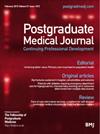关于经颅磁刺激疗法和经颅磁刺激疗法治疗精神分裂症患者幻听的疗效比较研究。
IF 3.6
4区 医学
Q1 MEDICINE, GENERAL & INTERNAL
引用次数: 0
摘要
目的:本研究旨在比较重复经颅磁刺激(rTMS)和连续θ-脉冲刺激(cTBS)对患有听觉言语幻觉(AVHs)的精神分裂症患者的治疗效果。通过评估运动诱发电位、阳性和阴性综合征量表(PANSS)、听幻觉评定量表(AHRS)、MATRICS共识认知测验(MCCB)的参数以及治疗前后血清神经营养因子的变化,比较临床疗效。结果治疗后,两种治疗方法的PANSS评分均有所下降,而cTBS组在阳性、阴性和一般症状方面的症状改善更为显著,凸显了cTBS的疗效。两组患者通过 MCCB 评估的认知功能也都有所改善,而 cTBS 的疗效普遍更高。两组患者治疗后血清中脑源性神经营养因子(BDNF)和胶质细胞系源性神经营养因子(GDNF)的水平均有所提高,其中 cTBS 的提高更为显著,而 GABA 和谷氨酸的水平则保持不变。我们的研究发现,经颅磁刺激和 cTBS 治疗对精神分裂症患者的 AVHs 均有疗效。然而,经颅磁刺激治疗的疗效通常高于经颅磁刺激治疗。本文章由计算机程序翻译,如有差异,请以英文原文为准。
Comparative study about the therapeutic effect of cTBS and rTMS in the treatment of auditory verbal hallucinations in schizophrenia.
OBJECTIVE
This study aims to compare the therapeutic effects of repetitive transcranial magnetic stimulation (rTMS) and continuous theta-burst stimulation (cTBS) treatment in schizophrenia patients with auditory verbal hallucinations (AVHs).
METHODS
We enrolled 64 schizophrenia patients with AVHs who were treated with either rTMS (n = 32) or cTBS (n = 32), and we compared the clinical outcomes by evaluating parameters from motor evoked potentials, Positive and Negative Syndrome Scale (PANSS), Auditory Hallucination Rating Scale (AHRS), and MATRICS Consensus Cognitive Battery (MCCB), as well as the changes of serum neurotrophic factors before and after the treatment.
RESULTS
After the treatment, both treatments resulted in reduced PANSS scores, with the cTBS group showing more substantial symptom improvement across positive, negative, and general symptoms, highlighting the enhanced efficacy of cTBS. Cognitive functions assessed by MCCB also improved in both groups, with cTBS showing a generally higher therapeutic effect. Serum levels of brain-derived neurotrophic factor (BDNF) and glial cell line-derived neurotrophic factor (GDNF) increased following treatment in both groups, with a more notable increase after cTBS, while GABA and glutamate levels remained unchanged. Cardiovascular indices were unaffected by either treatment, suggesting no significant impact on cardiovascular health.
CONCLUSIONS
Our study found that both rTMS and cTBS treatment can exhibit therapeutic effects in the management of AVHs in patients with schizophrenia. However, cTBS treatment generally shows a higher therapeutic effect than rTMS treatment.
求助全文
通过发布文献求助,成功后即可免费获取论文全文。
去求助
来源期刊

Postgraduate Medical Journal
医学-医学:内科
CiteScore
8.50
自引率
2.00%
发文量
131
审稿时长
2.5 months
期刊介绍:
Postgraduate Medical Journal is a peer reviewed journal published on behalf of the Fellowship of Postgraduate Medicine. The journal aims to support junior doctors and their teachers and contribute to the continuing professional development of all doctors by publishing papers on a wide range of topics relevant to the practicing clinician and teacher. Papers published in PMJ include those that focus on core competencies; that describe current practice and new developments in all branches of medicine; that describe relevance and impact of translational research on clinical practice; that provide background relevant to examinations; and papers on medical education and medical education research. PMJ supports CPD by providing the opportunity for doctors to publish many types of articles including original clinical research; reviews; quality improvement reports; editorials, and correspondence on clinical matters.
 求助内容:
求助内容: 应助结果提醒方式:
应助结果提醒方式:


